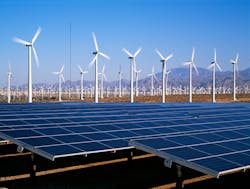U.S. Renewable Energy Consumption Surpasses Coal for First Time Since 1885
According to the U.S. Energy Information Administration's (EIA) recent Monthly Energy Review, in 2019, U.S. annual energy consumption from renewable sources exceeded coal consumption for the first since before 1885. This outcome mainly reflects the continued decline in the amount of coal used for electricity generation over the past decade as well as growth in renewable energy, mostly from wind and solar. Compared with 2018, coal consumption in the United States decreased nearly -15%, and total renewable energy consumption grew by +1%.
Historically, wood was the main source of U.S. energy until the mid-1800s and was the only commercial-scale renewable source of energy in the United States until the first hydropower plants began producing electricity in the 1880s. Coal was used in the early 1800s as fuel for steam-powered boats and trains and making steel, and it was later used to generate electricity in the 1880s. EIA’s earliest energy estimates began in 1635.
EIA converts sources of energy to common units of heat, called British thermal units (Btu), to compare different types of energy that are reported in different physical units (barrels, cubic feet, tons, kilowatt-hours, etc.). EIA uses a fossil fuel equivalence to calculate electricity consumption of noncombustible renewables such as wind, hydro, solar, and geothermal.
In 2019, U.S. coal consumption decreased for the sixth consecutive year to 11.3 quadrillion Btu, the lowest level since 1964. Electricity generation from coal has declined significantly over the past decade and, in 2019, fell to its lowest level in 42 years. Natural gas consumption in the electric power sector has significantly increased in recent years and has displaced much of the electricity generation from retired coal plants.
Total renewable energy consumption in the United States grew for the fourth year in a row to a record-high 11.5 quadrillion Btu in 2019. Since 2015, the growth in U.S. renewable energy is almost entirely attributable to the use of wind and solar in the electric power sector. In 2019, electricity generation from wind surpassed hydro for the first time and is now the most-used source of renewable energy for electricity generation in the United States on an annual basis.
To learn more about this milestone, read the original release from EIA.
